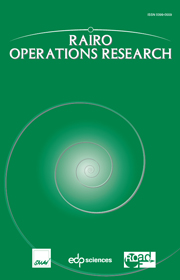Article contents
Comparing Imperfection Ratio and Imperfection Index for Graph Classes
Published online by Cambridge University Press: 04 April 2009
Abstract
Perfect graphs constitute a well-studied graph class with a rich structure, reflected by many characterizations with respect to different concepts. Perfect graphs are, for instance, precisely those graphs G where the stable set polytope STAB(G) coincides with the fractional stable set polytope QSTAB(G). For all imperfect graphs G it holds that STAB(G) ⊂ QSTAB(G). It is, therefore, natural to use the difference between the two polytopes in order to decide how far an imperfect graph is away from being perfect. We discuss three different concepts, involving the facet set of STAB(G), the disjunctive index of QSTAB(G), and the dilation ratio of the two polytopes. Including only certain types of facets for STAB(G), we obtain graphs that are in some sense close to perfect graphs, for example minimally imperfect graphs, and certain other classes of so-called rank-perfect graphs. The imperfection ratio has been introduced by Gerke and McDiarmid [12] as the dilation ratio of STAB(G) and QSTAB(G), whereas Aguilera et al. [1] suggest to take the disjunctive index of QSTAB(G) as the imperfection index of G.For both invariants there exist no general upper bounds, but there are bounds known for the imperfection ratio of several graphclasses [7,12]. Outgoing from a graph-theoretical interpretation of the imperfectionindex, we prove that there exists no upper bound on the imperfection indexfor those graph classes with a known bounded imperfection ratio.Comparing the two invariants on those classes, it seems that theimperfection index measures imperfection much more roughly than theimperfection ratio; we, therefore, discuss possible directions forrefinements.
- Type
- Research Article
- Information
- RAIRO - Operations Research , Volume 42 , Issue 4: ALIO/EURO V Conference on Combinatorial Optimization , October 2008 , pp. 485 - 500
- Copyright
- © EDP Sciences, ROADEF, SMAI, 2008
References
- 3
- Cited by


